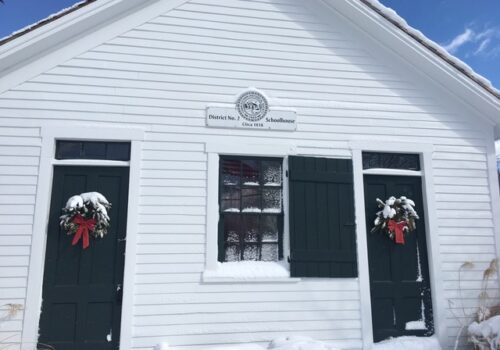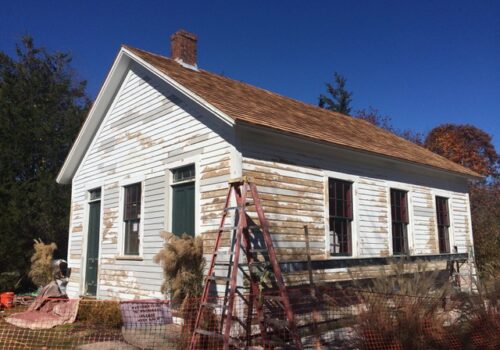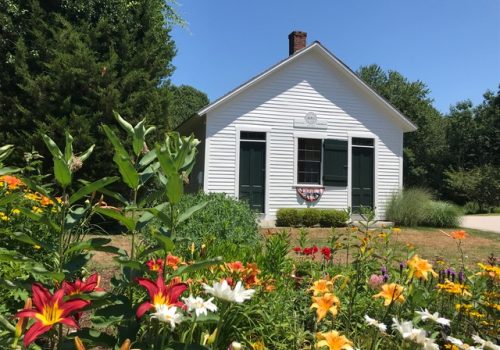This schoolhouse was one of eight schoolhouses built in Charlestown in the 1800s. Originally located in the Quonochontaug section of Charlestown, and built when there were only 26 stars on the US Flag, it fell into disrepair in the early 1900s, after being used as a private home and 4-H Club. It was donated to the Charlestown Historical Society in 1972, and moved to the Village of Cross’ Mills on the Cross Mills Public Library grounds, where it was lovingly restored by the CHS and opened to the public in 1973. The drip stones and field stone steps were also relocated with the building. Restoration work is ongoing, but the bones of the building remain in their original state. The schoolhouse is listed on the National Historic Register.
1838 District No. 2 Schoolhouse
Charlestown’s Eight District School Houses
(Quoted from Cole’s History of Rhode Island 1889)
District No. 1 – Cross’ Mills
This District is situated in the southeastern section of the town and named for the village within its limits. The citizens of the neighborhood built a house for educational purposes in 1843. From 1845 to 1860 perhaps no school in the town excelled this one in literary attainments; and in reference to teachers, without doubt this school has produced nearly as many as the other schools combined. The school building was repaired and reseated in 1874.
Records tell us that there was an earlier schoolhouse built by Thomas Perry, at Cross’ Mills, in 1801. This structure was located on the south side of the Cedar Swamp, and between forty and fifty rods to the east of the residence of George H. Ward. The school was maintained in this house for more than 25 years, but was finally purchased by Doctor Dan King, who moved it up west about one mile and a half to what is called “Kings Factory.” From 1801 to 1828, it was the only school house owned and used by the white people of Charlestown. (This paragraph was quoted from William Franklin Tucker’s Historical Sketch of the Town of C harlestown in Rhode Island: from 1636 to 1876)
District No. 2 – Quonocontaug
In this section of the state some of the hills, streams, rivers and ponds retain at the present time the original names given by the Indians. Quonocontaug is situated in the southwestern portion of the town, and this name appears first applied to a pond in this neighborhood, from which the district received it. Edward Wilcox, who was lieutenant governor from 1817 to 1821, transferred a lot of land to the district, upon which a school house was built in 1838. Although a respectable number of teachers have gone forth from other schools, still this school is entitled to the honor of educating an unusual number of good and faithful teachers.
District No. 3 – Cookstown
This division joins the town of Westerly, and it is really a rural district. The first school officers elected were the following: Bowen Briggs, moderator; Joseph W. Taylor, clerk; Benjamin F. Wilcox, Matthias Crandall and Rowland Peckham, Trustees; Perry Healy, treasurer; and Gardner Crumb, collector. Bowen Briggs and Gilbert Stanton conveyed a piece of land to the district in 1839, and a school building was erected during the year.
District No. 4 – Shumuncanuc
Here, in the northwestern part of the town, the surface is very hilly, and the people named the district after the most important hill. The citizens of this section met pursuant to notice, on the premises of Abram Allen, Esq., and selected a pleasant location for a school. Mr. Allen gave, then and there, the land on which the building was to be erected; and Mrs. Elizabeth Allen, wife of Abram, named it “Union Hill,” and paid one dollar for the honor of naming it. This building was raised on the 16th of September, and dedicated, by having a meeting in it, on the 13th of November 1834. The first structure, however, was burned down, and on November 10, 1845, Arnold and Nancy Hiscox deeded a parcel of land to the district, nearer the center, whereon the present school house stands.
District No. 5 – Pasquesett
The citizens were in meditation a long time before any conclusion was reached; and finally, in 1850, they purchased thirty rods of land of Robert Hazard, and built a school house thereon. The district, which is situated in the northern and central part of the town, takes its name from a small pond lying on its eastern border. In 1874 the school house was enlarged and thoroughly renovated, and furnished with desks and seats of the latest pattern. The extent of the territory and the advancement of the school considerably exceeds that of any other in the town.
District No. 6 – Washington
In 1828, Joshua Card, Joseph Cross, Henry Greene, David Clark, Elisha Greenman, William Card, Dan King, Jacob Perry and others agreed to build a school house. Henry Greene furnished the land, containing twenty-two square rods; and Elisha Greenman was appointed to superintend the work. According to date, this was the first school building erected by the white people of Charlestown, which continued to be used for school purposes; and it was named Washington, in honor of the first president of the United States. This district is situated in the northeastern part of the town. In 1871, Jason P. Greene, George W. Cross, Amos P. Greene and Henry S. Greene transferred the property to the district, with the proviso that when it should cease to be used for educational means, it should fall back to the original grantors; and, in the same year, the house was thoroughly repaired and supplied with modern desks and seats.
District No. 7 – Watchaug
The people of this district erected a school house in 1840, but a deed of the land on which the house stands was not granted until August 15, 1864. Watchaug is located in the south part of the town and derives its name from a large pond on the western boundary, so called by the Indians. There is no other district in Charlestown which has such a grand expanse of water within its limits, or bordering on its territory.
District No. 8 – Carolina
In 1845, Rowland G. Hazard, Esq., erected a school house in Richmond, northwest of the village; and, on the 13th of May, 1871, the property, consisting of a house and lot, was sold to the district for $700. Meanwhile, the children from the northern part of the district of Pasquesett attended school here, as it was more convenient so to do, and paid their proportion of the school fund of Charlestown to the school in Richmond. But on the 27th of January, 1872, District No. 8 of Charlestown, and No. 2 of Richmond, were consolidated, and named Carolina Joint District.




